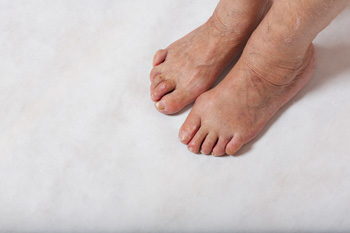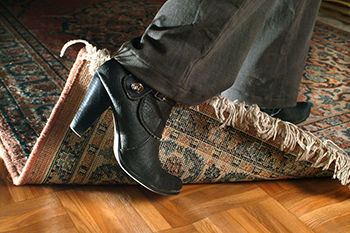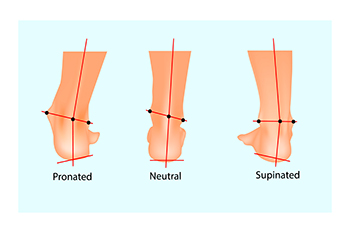Items filtered by date: January 2023
Putting Your Best Foot Forward

Toenail fungus is a condition causing white or yellowish spots to appear on the toenails. This will eventually lead to unsightly thickening, discoloration, and crumbling of the toenails. Aging and lack of moisture are frequent contributors to toenail fungus. As one ages, toenails become drier, more brittle, and cracked and this allows fungi to seep through. Having sweaty feet can also put one more at risk for developing toenail fungus. Previously having athlete’s foot might also increase the risk of getting toenail fungus. It is important to practice good routine foot care to prevent toenail fungus. Wash, dry feet well, and moisturize them daily. Wear properly fitting shoes, and do not go barefoot in areas with high moisture, like locker rooms and pool areas where fungi can breed quicker. If you think you have toenail fungus, see a chiropodist for verification and treatment.
Toenail fungus can be uncomfortable and unsightly. If you have diabetes or a compromised immune system, it may also be dangerous. To learn more about treatment options, please consult with one of the chiropodists from Complete Family Footcare & Therapy. Our clinicians will assess your condition and provide you with quality foot and ankle treatment.
What Does Toenail Fungus Look Like?
A fungal infection of the toenail may cause the affected nail to become thickened, brittle, crumbly, and yellowish or brown in color. Sometimes the toenail may separate from the nail bed, become deformed, emit a foul odor, or cause pain or discomfort.
What Causes Toenail Fungus?
Toenail fungus is caused by a fungus that infects the nail bed. The fungus lives and thrives in warm and moist environments and is also contagious. Athlete’s foot, which is a fungal infection of the skin, may spread to the nails and cause toenail fungus.
What Treatments Are Available?
Potential treatments for toenail fungus may include oral antifungal medications, topical antifungal medications, such as medicated nail polishes that are applied directly to the affected nail, and laser therapy. Sometimes, a combination of treatments is prescribed.
If you have any questions, please feel free to contact our offices located in . We offer the newest diagnostic and treatment technologies for all your foot care needs.
What Causes Hammertoe?

A hammertoe is when a toe is stuck in an upward bent position in the middle joint. It is one of the most common deformities of the forefoot. It can cause pain, swelling, redness, and callus formation on parts of the toe that rubs against shoes. Having a hammertoe can cause trouble with walking, maintaining balance, and doing other activities. Hammertoes can happen when the small muscles on the bottom of the foot are weaker than the larger muscles on the top of the foot. Hammertoes are more common among those with flat feet and longer metatarsals and those with diabetes or inflammatory arthropathies because these conditions affect the muscles, tendons, and nerves in the feet. One can also get a hammertoe from wearing shoes with heels that put pressure on the tips of the toes. Treatment options for hammertoe include stretches and exercises, taping, or surgery. If you have a hammertoe, see a chiropodist who can provide suggestions and treatment to increase your comfort.
Hammertoe is a common foot deformity in which one or more of the small toes bends downwards at the middle joint. Though it may seem like a purely cosmetic issue, this is not the case. Hammertoes can be uncomfortable, painful, and even debilitating in severe cases. If you suffer from hammertoe, please consult with one of the chiropodists from Complete Family Footcare & Therapy. Our clinicians can help you maintain the health of your lower limbs and your mobility.
Symptoms
-
One or more small toes bending downward at the middle joint
-
Pain or irritation on the affected toes
-
Corns and calluses
-
Inflammation
-
Redness
-
Stiff toe joints
-
Sores on the tops of the toes
Diagnosis
A chiropodist can typically diagnose hammertoes through physical examination. X-rays may need to be taken to see the extent of the damage.
Treatment
Hammertoes tend to progressively worsen with time, so getting prompt treatment is very important. In its early stages, the progression of hammertoe can be slowed down or stopped. Your chiropodist may suggest changes in your footwear. Wearing wide, comfortable shoes with a larger toe area and a low heel can help you avoid putting pressure on your toes. You may also be prescribed orthotics. Over-the-counter medications or corticosteroid injections may be used to relieve pain. If you have any corns or calluses, your chiropodist may suggest padding them to avoid further irritation. In advanced cases, surgery may be suggested.
If you have any questions, please feel free to contact our offices located in . We offer the newest diagnostic and treatment technologies for all your foot care needs.
Skills and Education Needed for Chiropodists

Chiropodists are medical professionals who specialize in diagnosing and treating conditions of the feet and ankles. The goal of the chiropodist is to have the patient maintain mobility, which generally begins with determining the cause of foot pain. Education consists of earning a bachelor's degree and completing three years of qualified courses. In addition to this mandatory schooling, it is beneficial for the interested individual to have good communication skills and the ability to work under pressure. Many chiropodists choose to become self-employed or to work in a hospital. Additional choices include becoming part of a group practice or managing an outpatient clinic. If you are interested in pursuing this field of medicine, it is advised that you meet with a chiropodist who can answer questions you may have and guide you toward making the right career choice.
If you have any foot or ankle concerns, contact one of the chiropodists of Complete Family Footcare & Therapy. Our clinicians can provide the care you need to keep you on your feet.
A chiropodist is a healthcare professional that specializes in the feet, ankles, and lower limbs. With the amount of work the feet do in a lifetime, the whole body works better if the feet are properly supported. Chiropodists must have a bachelor’s degree in science and complete a three to four-year chiropody program. They can then work independently or as part of a team. Chiropodists are like podiatrists, the only difference being the country they obtained where they obtained their degrees. The field can be called podiatry in the United States and chiropody elsewhere. A chiropodist is a popular term for this profession in the UK and Canada. Chiropodists treat a variety of foot problems from corns and calluses to fungal infections. Some also offer orthotics. They might provide a variety of foot therapies, injections, and surgical procedures. Normally one sees a chiropodist when they are experiencing pain but visiting one regularly, as one would a dentist, can help ensure the feet are in top form and help prevent future problems. If you suffer from foot or ankle pain or have questions about your lower extremities, book an appointment with a chiropodist today.
What Does a Chiropodist Do?
A chiropodist helps people with problems with their feet and ankles with the goal of making their lives more comfortable. A chiropodist takes care of blisters, corns, bunions, cracked heels, nail problems, and sprained ankles, just to mention a few things that can go wrong with our feet. A chiropodist will take your medical history and examine your feet for blood circulation and any other problems going on. They will watch you walk and how you move when you walk. They will discuss any findings they come up with and discuss a treatment plan with you.
What Does It Take to Become a Chiropodist?
Chiropodists must have seven to eight years of post-secondary school before beginning to practice. They must obtain a bachelor’s degree in science and complete a three-to-four-year chiropody program. Chiropodists work independently or as part of a team.
If you have any questions please feel free to contact our offices located in North York and Mississauga, ON . We offer the newest diagnostic tools and technology to treat your foot and ankle needs.
The Importance of Preventing Falls

While anyone can fall at any age, the older one is, the more common falls are. Unfortunately, falls can cause serious injuries and can interfere with mobility and independence. Among other things, falls can happen in seniors due to side effects of medication, vision impairment, and chronic health conditions. It is important for seniors to have their living environments checked for risks, such as tripping hazards, poor lighting, and securing locks on assistive devices. It is also essential to be on top of their health and keep as active as possible in the quest to prevent falls. A chiropodist can assist in educating you about things to tend to in preventing falls and examine your feet for any contributing factors. If a fall occurs and you hurt your feet or ankles, a chiropodist can also assist in treating injuries.
Falls are a common but preventable problem for older adults. If you would like to learn more about preventing falls, please consult with one of the chiropodists from Complete Family Footcare & Therapy. Our clinicians can help you maintain the health of your lower limbs and your mobility.
Did you know that most falls occur in the home? Fortunately, there are many simple changes that you can make to the living environment to reduce the risk of falling.
In the Bathroom:
-
Install grab bars near toilets, bathtubs, and showers
-
Put non-skid mats on all surfaces that may get wet
In the Bedroom:
-
Keep a light near the bed so that you can easily turn it on if you have to get up at night
-
Keep the path from your bedroom to the bathroom clutter-free and well-lit
-
Consider installing a bed rail for added support
In the Kitchen:
-
Use non-skid mats
-
Wipe up any spills immediately
-
Move commonly used items to areas that are easily within your reach
In the Hallways:
-
Place handrails on both sides of the stairs
-
Install good lighting in the hallways and around the entire home
-
Keep hallways free of clutter
-
Don’t use throw rugs or small area rugs
In Other Living Areas:
-
Keep loose cables, cords, and wires near the wall and away from walking surfaces
-
Make sure that all carpets and rugs are secure firmly to the floor
-
Arrange your furniture so that it is not in your way when you walk
-
Use chairs and couches that you can easily get up from
If you have any questions, please feel free to contact our offices located in . We offer the newest diagnostic and treatment technologies for all your foot care needs.
It's Time for Beautiful Feet
What Is Overpronation?

Overpronation is when the foot and leg are not aligned, and the foot turns inward excessively from its neutral line. The foot rolls forward into the arch. Walking and running trigger this reflex where the knees tilt in and the arches flatten. Many people are affected by this condition, especially as they age, and it can cause pain in the feet, ankles, and legs. Orthotics and stability shoes are often suggested to help with overpronation. Most people who overpronate have flat feet or collapsed arches. Some other causes of overpronation include genetics, athletic activity, or ill-fitting shoes. A gait analysis will show whether you over- or under-pronate. It is a good idea to visit a chiropodist to have such an analysis done with the goal of preventing chronic foot pain from developing.
Foot problems can become increasingly common as we age, making everyday foot care especially important. To learn more about maintaining proper foot health, please consult with one of the chiropodists from Complete Family Footcare & Therapy. Our clinicians will assess your condition and provide you with quality foot and ankle treatment.
Common Foot Problems
Certain foot problems may be more likely to affect older adults.
Some examples of foot conditions that can be common in older adults include:
-
Dry, cracked skin
-
Calluses and corns
-
Blisters
-
Ingrown toenails
-
Deformities such as bunions or hammertoes
-
Fungal infections
-
Plantar warts
Systemic conditions, such as diabetes or arthritis, are also more likely to affect older people and manifest symptoms in the feet and ankles.
Daily Foot Care Tips
Having a daily foot care routine can help detect problems early on and prevent future issues.
Things that you can do at home to care for your feet include:
-
Washing the feet daily with warm water, drying them thoroughly, and then applying a moisturizer
-
Trimming the toenails straight across and not too short to prevent ingrown toenails
-
Performing daily foot exercises to improve foot strength and mobility
-
Wearing shoes when walking to avoid injury
-
Inspecting the feet daily for any cuts, scrapes, sores, or other abnormalities and seeking prompt treatment if any problems are discovered
If you have any questions, please feel free to contact our offices located in . We offer the newest diagnostic and treatment technologies for all your foot care needs.

